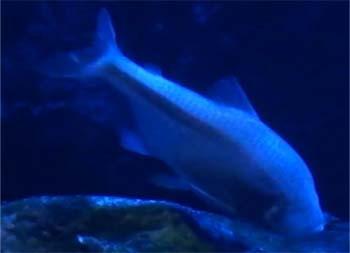

mexicanus reproductive behavior, on its possible evolution after cave colonization, and on the sensory modalities that help or trigger this behavior. However, there is an important lack of knowledge on A. It posits that there is no barrier to reproduction between the two morphs in terms of sex determination mechanism and behavior. This holds true both in the laboratory where crosses between morphs is the basis for genetic studies, and in the wild where hybridization can occur after surface fish are washed into caves after flooding during the rainy season. Indeed, cave and surface morphs can reproduce and give a fertile progeny. mexicanus differ by many traits in terms of morphology, physiology and behavior, yet they belong to the same species, with reproductive isolation and interfertility taken as criteria to define a species.

mexicanus have thus become popular for evolutionary biology studies focusing on the mechanisms of adaptation after a drastic environmental change, and on the analysis of troglomorphic features. This system is unique because it gives the opportunity to compare extant surface fish and several cavefish populations of the same species, and genetic analyses involving the production of hybrids are possible. Importantly, cave colonization occurred recently, probably less than 25.000 years ago, suggesting that cave adaptation was rapid. Several lines of evidence (genetic, phylogeographic, developmental) indicate that the two forms derive from a common ancestor that was “surface fish–like” and was eyed and pigmented (see reviews in ). The river-dwelling morphs inhabit South, Central America and Texas, and the blind depigmented cave-dwelling morphs live in the permanent darkness of 30 caves in North-Eastern Mexico. The characiform fish Astyanax mexicanus, or Mexican tetra, comes in two distinct forms. These results are discussed with regards to the sensory modalities involved in triggering reproductive behavior in the two morphs, as well as its possible ongoing evolution. Lastly, egg production seemed higher in surface fish females than in cavefish females. Finally, cavefish female pheromonal solution was able to trigger strong behavioral responses in cavefish males–but not on surface fish males.

However, breeding between cavefish females and surface fish males was more frequent than the reverse. Accordingly, cross-breeding experiments involving females of one morphotype and males of the other morphotype showed the same behavior including the same five phases. Such features may constitute “pre-adaptive traits” which have facilitated fish survival after cave colonization, and may also explain how the two morphs can hybridize in the wild and in the laboratory. Using infrared video recordings, we showed that cave and surface Astyanax spawning behavior is identical, occurs in the dark, and can be divided into 5 rapid phases repeated many times, about once per minute, during spawning sessions which last about one hour and involve one female and several males. mexicanus, with the goals of documenting the spawning behavior in this emerging model organism, its possible evolution after cave colonization, and the sensory modalities involved. Here we have compared the breeding behavior of the surface-dwelling and cave-dwelling morphs of the characiform A. Fish reproductive patterns are very diverse in terms of breeding frequency, mating system, sexual dimorphisms and selection, mate choice, spawning site choice, courtship patterns, spawning behaviors and parental care.


 0 kommentar(er)
0 kommentar(er)
